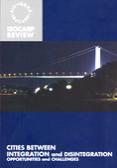urban theory social exclusion/integration premio letteratura urbanistica safety & security scali ferroviari social practices regulation urban africa city-regions dottorati welfare cities knowledge fabrication land use planning renaissance rigenerazione urbana social capital open spaces globalization parks urban policies public spaces Environment
Cities between integration and disintegration: opportunities and challenges
The ISOCARP Review is the title of thematic publications that complement the research efforts prepared for the annual ISOCARP Congresses.
In particular, "Cities between integration and disintegration: opportunities and challenges" was published in 2006 at the occassion of the ISoCaRP 42nd International Planning Congress in Istanbul.
The 2006 ISoCaRP Congress had focused on the theme of the contemporary challenges and emerging opportunities that cities are facing .
“ Some influential forces that can be summarised as integrative and disintegrative. By integrative forces we refer to strategies formulated by urban stakeholders to position their cities in the global arena, including institutional actions undertaken via growth-friendly policy and market initiatives realised through mega projects.
These set of efforts aiming for urban competitiveness have nevertheless revealed the other side of the coin ; how cities have become exposed to tides of disintegrative forces, which, scholars assert, has caused urban systems to be drawn to spatial, cultural, social and economic fragmentation.”
CONTENTS
Foreword
Introduction
• Preventing the goose with the golden eggs from catching bird flu - Unesco's efforts in safeguardinf the historic urban landscape,
by Ron Van Oers
• Ecosystem approaches and urban environmental planning,
by Peter J. Marcotullio
• Asian cities between integration and disintegration. Can small and medium cities survive in the global age?,
by Norihisa Shima and Takashi Onishi
• A green core. For the polycentric urban region of central Tuscany and the Arno master plan,
by Alberto Magnaghi
• Interpreting the breakdown of the urban model. Three Italian case studies,
by Patrizia Gabellini
• Accomodating diversity. Housing strategies for an integrated multi-ethnic society,
by Sako Musterd
• Opportunities for integration. The Turkish case: return to villages and rehabilitation project,
by H. Cagatay Keskinok
• Vienna's "Gentle renewal" while being confronted with "Robust" challenges by the present,
by Oliver Frey and Kurt Smetana
• Barriadas and elite in Lima, Peru. Recent trends on urban integration and disintegration,
by Ana Marìa Fernàndez-Maldonado
• Rotterdam. Living with water; Water city 2035,
by Liese Vonk
• Evaluating Istanbul in the process of European Capital of culture 2010,
by Eda Beyazit and Yasemin Tosun
• Integration and disintegration. The view from the urban region,
by David C. Prosperi
• Planning to incorporate community participation? City visioning strategies and institutional challenges,
by Ellie Francis- Brophy
• The long and winding road. Peripheries in a medium sized city of southern Italy,
by Paolo La Greca, Francesco Martinico, Sara Occhipinti, Agatino Rizzo
• Book reviews,
by Pierre Laconte and Francesco Martinico
About the authors
ABOUT ISoCaRP
The International Society of City and Regional Planners (ISoCaRP) is a global association of experienced professional planners.
It was founded in 1965 in a bid to bring together recognised and highly-qualified planners in an international network. The ISoCaRP network consists of both individual and institutional members from more than 70 countries.
The objectives of ISoCaRP include the improvement of planning practice through the creation of a global and active network of planners. ISoCaRP encourages exchange between planners, promotes the profession in all aspects, stimulates research, improves education and training, increases information and awareness on major planning issues.
The association’s main event is the annual World Congress, which focuses on an international planning theme. The congress takes place in a different country every year, preferably in a different continent. ISoCaRP also organizes smaller scale seminars and publishes reports and other professional documents. It is represented at major international planning events.




Planum
The Journal of Urbanism
ISSN 1723-0993
owned by
Istituto Nazionale di Urbanistica
published by
Planum Association
ISSN 1723-0993 | Registered at Court of Rome 4/12/2001, num. 514/2001
Web site realized by ChannelWeb & Planum Association | Powered by BEdita 3

